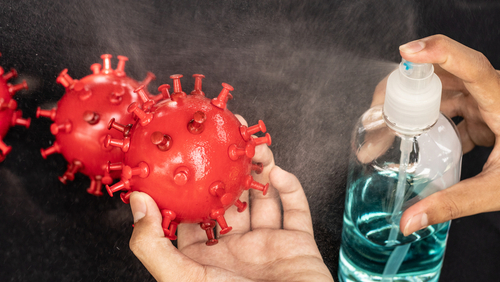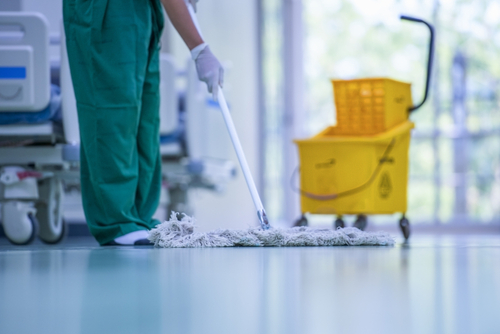
Why Choose Us as Your Self Disinfecting Coating Provider
October 8, 2020
What Is Antimicrobial Coating And Is It Useful?
November 4, 2020How Does Antimicrobial Coating Work?

Wondering how does antimicrobial coating work? Recently, there has been a sharp rise in the use of antimicrobial coatings, and the entire industry has been expanding rapidly. Antimicrobial coating hinders the growth of bacteria and germs on surfaces of various types.
The Healthcare sector has seen the highest growth as well as demand for antimicrobial coating. Antimicrobial Coating Technology is probably the most effective means of controlling infection in the healthcare sector without having to compromise on the care of the patient.
Before moving on to understand how antimicrobial coating works, let us first understand why antimicrobial coating is important.
Antimicrobial coatings provide excellent protection from bacteria, mold, and fungi. They also minimize staining and odors and prevent the surfaces from degradation on which they are applied. As the name itself suggests, microbes do not grow or survive on a surface where these coatings are applied. Hence, these coatings prove to be highly cost-effective and long-lasting.

Moreover, antimicrobial coatings greatly improve how clean a healthcare setting is. One can avoid using cleaning agents if they have used the antimicrobial coatings. According to some surveys, most doctors and healthcare professionals prefer using antimicrobial coatings to disinfectants and active cleaning agents because they shield the surfaces from parasites, germs, bacteria and other harmful microorganisms.
Metals that have antimicrobial properties, for example, copper and silver, are used as antimicrobial coatings and shield medical devices from infections. The application of these coatings ranges from medical electronics to catheters, on the condition of being non-toxic and biocompatible.
Continue reading the article to know how does Antimicrobial Coating work
- 1. Despite top-notch precautions taken by medical and healthcare professionals, infections occur in about 14% of patients after stabilizing an open fracture and about 2% of patients who undergo joint prostheses.

These infections can be prevented by coating the surfaces of the devices used in the procedures with antimicrobial agents so that the growth of infection generating bacteria can be prevented.
These devices are generally made of titanium and are coated with an antiseptic concoction of chlorxylenol and chlorhexidine. This antiseptic concoction has been proven to successfully prevent the growth of five infection causing organisms such as Escherichia coli.
- 2. Copper and copper alloys have been proven to kill more than 99.9% of bacteria that cause diseases.

355 different compositions of the copper alloy have been granted the status of antimicrobial metal. In the healthcare sector, products made of copper such as sinks, doorknobs, keyboards, handrails, and bed rails are included.
In public facilities, copper alloy applications are used in elevator buttons, gym equipment, and handles of shopping carts. Footboards, kitchen surfaces, toilet hardware, and bedrails are the products made of copper in residential buildings.
Studies indicate that spaces, where surfaces that are commonly touched are replaced with alloys of copper, demonstrate a ninety-seven percent reduction in pathogens that are found on surfaces.
- 3. Titanium Dioxide and Zinc Oxide are two such photoactive pigments that are used as antimicrobial coatings on surfaces like steel, ceramic, and glass.

Titanium Dioxide is well known for its antimicrobial properties. Titania has also been used successfully as an antimicrobial coating on surfaces like windows, paving slabs, bathroom tiles, etc.
- 4. Another metal that shows excellent antimicrobial properties is Silver.

Its compounds and ions have been extensively used in water treatment. Silver ions are photoactive when in presence of UV-A and UV-C irradiation and thus leads to the UV inactivation of viruses and bacteria.
Other uses of Antimicrobial coatings

Antimicrobial coatings are applied on surfaces like parts of vehicles and automobiles, aquarium filters, air purifiers, air conditioners, wood, fiberglass and plastics. Synthetic overcoats, felt and tiles also require antimicrobial coatings for extra protection from germs. Other manufactured products that include antimicrobials are paints, foam cushions and growth medium for plants and crops.
How Does Antimicrobial Coating Work? – Conclusion
The demand for antimicrobial coatings is rapidly growing more than ever because various microbial and superbugs have been showing resistance to the currently used drugs.
Copper, titanium, and silver are some metals that are notably very popular for their antimicrobial and antibacterial properties. However, there is constant research going on to find other types of coatings.
These include hydrophilic coatings that can be molded in any manner to be suitable for specific devices and nanostructured surfaces that are capable of mimicking nature.




